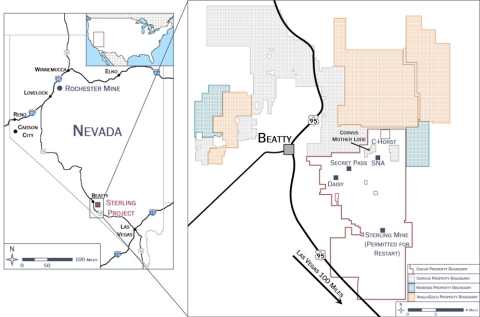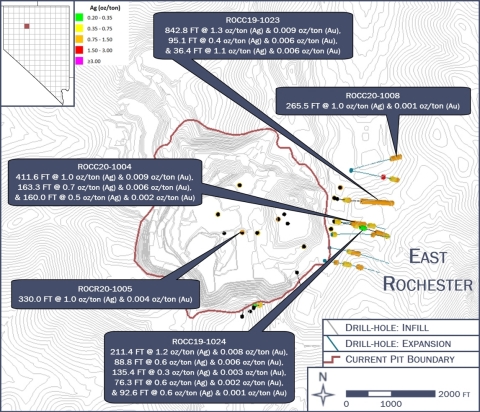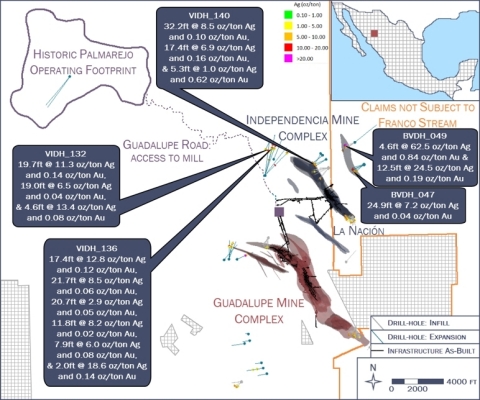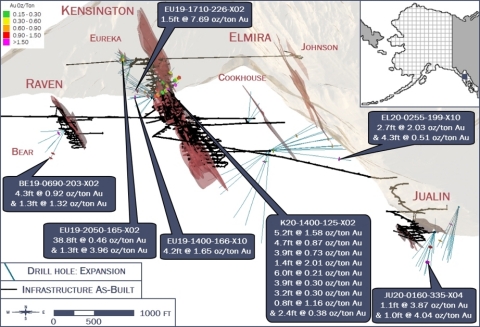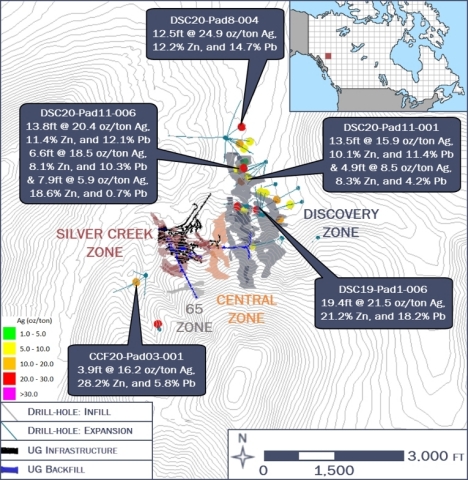CHICAGO--(BUSINESS WIRE)--Coeur Mining, Inc. (“Coeur” or the “Company”) (NYSE: CDE) today provided an update on its 2020 exploration program, which is the largest campaign in the Company’s history. The primary focus of the program is resource expansion and new discoveries, including prospective step-out drilling on certain targets designed to test known boundaries of existing mineralization. Drilling was active at six of the Company’s sites during the first half of 2020 with each program delivering positive results, including two new gold discoveries at the Sterling and Crown exploration properties in southern Nevada.
Key Highlights1,2
-
New, significant discoveries in Nevada of oxide gold at Sterling and Crown – Step-out drilling at both Sterling and Crown has discovered new mineralized zones: (i) El Portón, located to the northeast of the historic Sterling mining area and (ii) C-Horst, located in the northernmost portion of the Crown Block. The new discoveries exhibit oxide-leach characteristics based on initial metallurgical test work and cyanide-fire assay results. Key highlights include:
-
El Portón
- Hole STR20-018 returned 380.0 feet (115.8 meters) of 0.09 ounces per ton (“oz/t”) (3.0 grams per tonne (“g/t”)) gold from 585.0 feet (178.3 meters) drill depth, and
- Hole STR20-032 returned 250.0 feet (76.2 meters) of 0.04 oz/t gold (1.4 g/t) from 660.0 feet (201.2 meters) drill depth
-
C-Horst
- Hole CH20-007 returned 320.0 feet (97.5 meters) of 0.04 oz/t (1.4 g/t) gold from 540.0 feet (164.6 meters) drill depth, and
- Hole CH20-008 returned 265.0 feet (80.8 meters) of 0.03 oz/t (1.1 g/t) gold from 535.0 feet (163.1 meters) drill depth
-
El Portón
-
Meaningful new, higher-grade mineralization adjacent to open pit at Rochester – Grades and thicknesses from directional drilling demonstrate potential growth of higher-grade mineralization immediately east of the existing open pit at Rochester. This data is expected to be incorporated into the rescoped mine plan as part of the upcoming expansion at Rochester. Additionally, the Company plans to issue an updated technical report during the fourth quarter of 2020. Key highlights from East Rochester include:
- 842.8 feet (256.9 meters) of 1.3 oz/t (45.4 g/t) silver and 0.009 oz/t (0.3 g/t) gold
- 411.6 feet (125.5 meters) of 1.0 oz/t (33.6 g/t) silver and 0.009 oz/t (0.3 g/t) gold, and
- 211.4 feet (64.4 meters) of 1.2 oz/t (40.8 g/t) silver and 0.008 oz/t (0.3 g/t) gold
-
Expansion drilling at Palmarejo targeting new, high-grade discoveries – Expansion drilling north and east of the Independencia mine complex has returned positive results above resource grade thickness cutoff, highlighting the potential for future growth with continued drilling. Resource expansion drilling also has been successful to the west of the Independencia mine complex towards the Palmarejo mill. Notable results from the program include:
-
North Independencia
- Hole VIDH_140 returned 32.2 feet (9.8 meters) of 0.10 oz/t (3.3 g/t) gold and 8.5 oz/t (290.9 g/t) silver
-
Northwest Independencia
- Hole VIDH_132 returned 19.7 feet (6.0 meters) of 0.14 oz/t (4.7 g/t) gold and 11.3 oz/t (387.9 g/t) silver
-
North Independencia
-
Multiple high-grade intercepts outside existing mining area at Kensington – High-grade assay results have been returned from upper Kensington Zone 30, Raven, Elmira and Eureka, all of which are located near existing infrastructure and represent new potential resource growth areas. A single drillhole (K20-1400-125-X02) from the southern portion of upper Kensington Zone 30 cut multiple high-grade intercepts, including:
- 5.2 feet (1.6 meters) of 1.58 oz/t (54.2 g/t) gold,
- 4.7 feet (1.4 meters) of 0.87 oz/t (29.8 g/t) gold,
- 3.9 feet (1.2 meters) of 0.73 oz/t (25.0 g/t) gold,
- 1.4 feet (0.4 meters) of 2.01 oz/t gold (68.8 g/t), and
- 0.8 feet (0.2 meters) of 1.16 oz/t (39.7 g/t) gold
-
Accelerated drill program at Silvertip testing limits of known mineralization – Resource expansion drilling north, east and south of the Discovery zone, and in the new South Camp Creek zone has intercepted multiple stacked manto horizons with resource-grade assay results. North of the Discovery zone, the geologic team has re-interpreted historic geologic and geophysical data to make a discovery at the new Keda zone, located approximately 1.0 mile (1.6 kilometers) north of the Discovery and Silver Creek resources. New drillholes demonstrate the potential for resource growth with over two miles (3.5 kilometers) of north-south strike length, more than triple the previous resource strike length. Key highlights of the program include:
-
Discovery East
- Hole DSC19-Pad1-006 returned 19.4 feet (5.9 meters) of 21.5 oz/t (736.0 g/t) silver, 21.2% zinc and 18.2% lead
-
Discovery North
- Hole DSC20-Pad8-004 returned 12.5 feet (3.8 meters) of 24.9 oz/t (855.0 g/t) silver, 12.2% zinc and 14.7% lead
-
Discovery East
Through the end of second quarter 2020, Coeur drilled 343,258 feet (104,625 meters) at a total investment of approximately $21.0 million ($18.3 million expensed and $2.8 million capitalized), compared to 258,418 feet (78,767 meters) at a total investment of roughly $13.4 million ($9.4 million expensed and $4.0 million capitalized) in the first six months of 2019. The Company expects to invest $44 - $54 million in exploration in 2020, including $37 - $43 million and $7 - $11 million of expensed and capitalized exploration, respectively3. Coeur remains committed to allocating capital prudently to its success-based exploration programs, further advancing its efforts to discover new resources and convert existing resources to reserves in order to extend mine life.
“This has been a very exciting year for Coeur’s exploration programs and one of the best first halves of drilling results in the Company’s history,” said Hans J. Rasmussen, Coeur’s Senior Vice President of Exploration. “We have identified several prospective areas over the past few years to build our inventory of drill-ready targets. We significantly increased our investment in exploration to test these targets in 2020, seeking to provide stockholders with upside exposure to new potential discoveries and mine life extensions at our existing operations. We are now seeing results that validate our investment rationale, including the new C-Horst discovery in southern Nevada, which ties to our strategic objective of having a solid balance of near-, medium- and long-term, high-return organic growth opportunities. Importantly, over 70% of our exploration budget this year is focused on near-mine resource growth and new discoveries, with notable intercepts at each project we’ve drilled. These are the first steps in our efforts to add to our resource base and represent an opportunity for Coeur to meaningfully increase the size of its reserves over the next few years.”
For a complete table of all drill results, please refer to the following link: https://www.coeur.com/_resources/pdfs/2020-08-11_Exploration_Update_Appendix_-_Final.pdf. Please see the “Cautionary Statements” section for additional information regarding drill results.
Sterling and Crown1,2
The Company’s Sterling and Crown exploration properties cover approximately 35,500 net acres (14,365 hectares) of highly prospective land in southern Nevada. The properties are located within the Bare Mountain district, which hosted one of the most widely spread historical mineralization events in Nevada and is known to be a target-rich environment for new discoveries.
Coeur believes that the geology of this area exhibits potential to support significant gold mineralization, similar to other host rock formations in Nevada’s Carlin and Cortez Trends. As Coeur has advanced its exploration efforts at Sterling and Crown, several other companies have grown their land positions and are currently executing drill programs around the district.
Up to three reverse circulation rigs and one core rig were active at Sterling and Crown during the first half of 2020, continuing to target areas of oxide gold mineralization. The Company drilled 88,437 feet (26,956 meters) at a total investment of approximately $5.5 million ($5.3 million expensed and $0.3 million capitalized). Additionally, detailed surface geologic mapping and sampling have been ongoing at both Sterling and Crown during the drill programs.
At Sterling, one reverse circulation rig started the year infill drilling near the existing resource. The program then transitioned to expansion drilling, which focused on structural targets that were identified in 2019 from surface geology, airborne magnetics and ground gravity surveys. These efforts proved successful as the expansion drilling yielded the discovery of the El Portón zone, located northeast of the historic Sterling mining area.
Following the success of the two initial drillholes mentioned in the beginning of this news release, Coeur completed a new geologic model for the Sterling mine and El Portón zone. Interpretation of the results from the new model suggests that mineralized faults from the 144 Zone connect to El Portón.
Since most of the interpreted mineralized faults are obscured by alluvial cover, the new geologic interpretation relies heavily on drill logs, surface mapping of limited outcrop and geophysical data. Leveraging these tools, Coeur drilled ten additional holes at El Portón during the second quarter of 2020, attempting to follow the zone intersected in hole STR20-018 with assay results expected during the third quarter of 2020.
In the Crown Block, exploration focused on testing the outer boundaries of mineralization at the Daisy, SNA and Secret Pass deposits as well as the newly discovered C-Horst zone, which is located in the northernmost portion of the land package. Targets at C-Horst were generated based on geophysical data and projections of known faults from the SNA and Mother Lode (Corvus Gold Inc.) deposits. The second hole hit significant mineralization:
- Hole CH20-002 returned 235.0 feet (71.6 meters) of 0.05 oz/t (1.8 g/t) gold and 50.0 feet (15.2 meters) of 0.01 oz/t (0.4 g/t) gold
Once Coeur received and interpreted the results, an additional rig was mobilized to continue testing the area. The Company has drilled 18 holes through the first half of 2020, receiving results from ten drillholes with assays pending for the remaining eight. Initial results from drilling suggests that the gold mineralization remains open in all directions at C-Horst.
Highlights from the assays received thus far include holes CH20-007 and CH-008 (included in the “Key Highlights” section) as well as:
- Hole CH20-006 returning 145.0 feet (44.2 meters) of 0.02 oz/t (0.6 g/t) gold, and
- Hole CH20-010 returning 95.0 feet (29.0 meters) at 0.02 oz/t (0.5 g/t) gold
Cyanide to fire assay ratios from lab results suggest the C-Horst zone is oxidized and has potential to be amenable to heap-leaching. Five bottle roll tests were also completed on five separate mineralized horizons, resulting in recoveries of 68% - 89% on four samples. The other sample had a 42% recovery rate with the recovery improving to 92% with additional leach time, indicating the potential for coarse gold. Notably, the leach characteristics are in-line with the cyanide to fire assay ratios received from the lab.
Coeur will continue to proactively manage the drill programs at Sterling and Crown following its success-based capital allocation framework. The Company plans to conduct limited exploration at Sterling for the remainder of 2020, although Coeur may reallocate more funds in its budget to Sterling if additional positive results are retuned from the pending assays at El Portón.
Expansion drilling at Crown is expected to continue during the second half of the year. Coeur expects the pace of drilling to be maintained with one reverse circulation rig focused primarily at C-Horst for the foreseeable future. The Company also plans to add a diamond core rig to drill targets at Daisy, SNA and C-Horst to provide core samples for density analysis, engineering and metallurgical testing. Additionally, Coeur anticipates receiving its larger 300-acre disturbance permit for the Crown Block in the third quarter of 2020.
Rochester1,2
The primary focus of the exploration program at Rochester in 2020 is expansion drilling at East Rochester as well as infill drilling beneath the open pit to further improve the economics of the upcoming expansion project. Through the first half of 2020, Coeur drilled 27,704 feet (8,444 meters) at a total investment of approximately $2.7 million ($2.1 million expensed and $0.6 million capitalized). Two core rigs and one reverse circulation rig have been active at Rochester since early April 2020.
A total of eight holes have been drilled into East Rochester through the first half of 2020, following on the success of two-holes drilled in late 2019 (holes ROCC19-1023 and -1024), employing directional core drilling technology. East Rochester is located approximately 1,000 feet (300 meters) east of Rochester’s open pit and adjacent to existing infrastructure. The directional drilling allows the core to be cut at a shallow angle, which enables the Company’s exploration team to better estimate true thicknesses and grades across the zone.
Assays returned from East Rochester demonstrate a consistently large mineralized zone that has the potential to significantly increase the size of Rochester’s existing resource base.
Assay results from East Rochester also consistently have been two to three times higher than Rochester’s current inferred resource grade of 0.4 oz/t (12.2 g/t) silver and 0.002 oz/t (0.1 g/t) gold4. Based on the success of the program, Coeur has allocated funding to conduct four additional direction core holes into East Rochester.
Additionally, a total of 31 reverse circulation holes have been drilled in the bottom of Rochester’s open pit as part of the infill program designed to test mineralization below the water table. Several results have demonstrated upside potential in the area below the previously modeled pit bottom. One example came from hole ROCR20-1005, which returned 330.0 feet (100.6 meters) of 1.0 oz/t (33.7 g/t) silver and 0.004 oz/t (0.1 g/t) gold – more than double the average reserve grade at Rochester4. Building on the success of these results, the Company is reviewing its next steps and plans to conduct additional drilling, metallurgical testing and resource modeling to understand the potential to expand the depth of the open pit.
At the properties acquired from Alio Gold Inc in late 2018, including the Lincoln Hill district and Wilco project, a compilation of all available digital geologic, geochemical and geophysical data has been completed. Drill targeting that utilizes this new data has identified several potential growth areas, which are included in a new 200-acre drill permit (expected in mid-2021). The Lincoln Hill district, including the Independence Hill, Gold Ridge and Red Hill targets, has the potential to grow significantly with new drilling. Together, these targets are anticipated to be among the Company’s highest priorities for growth given their proximity (approximately three miles west) to the new leach pad that will be built as part of the upcoming expansion at Rochester.
Palmarejo1,2
Coeur’s top exploration goal at Palmarejo in 2020 is to discover new mineralization and further extend the mine life by focusing on targets near existing infrastructure at the Independencia and Guadalupe mine complexes. There was a temporary suspension of exploration activities during the second quarter of 2020 in accordance with a COVID-19 driven government decree, but four rigs were active by the end of June and two additional rigs were mobilized in July.
Through the first half of 2020, Coeur drilled 96,771 feet (29,496 meters) at a total investment of approximately $4.1 million ($2.4 million expensed and $1.8 million capitalized), with up to eight core rigs active simultaneously.
Exploration activity was initially focused primarily on resource conversion and expansion drilling around the Guadalupe mine complex. The Company then gradually migrated more rigs to the Independencia mine complex, testing the extension of the veins to the north and south. Notably, assay results have returned multiple intervals above Palmarejo’s current inferred resource grade of 0.06 oz/t (1.9 g/t) gold and 4.1 oz/t (139.6 g/t) silver4. Key highlights include:
-
New resource expansion intercepts from the northwestern portion of the Independencia mine complex where multiple wide intercepts were cut. Key results from each vein include:
-
North Independencia – Hole VIDH_140, additional intercepts
- 17.4 feet (5.3 meters) of 0.16 oz/t (5.4 g/t) gold and 6.9 oz/t (236.4 g/t) silver, and
- 5.3 feet (1.6 meters) of 0.62 oz/t (21.4 g/t) gold and 1.0 oz/t (35.7 g/t) silver
-
Northwest Independencia – Hole VIDH_136
- 17.4 feet (5.3 meters) of 0.12 oz/t (4.0 g/t) gold and 12.8 oz/t (439.1 g/t) silver,
- 21.7 feet (6.6 meters) of 0.06 oz/t (2.1 g/t) gold and 8.5 oz/t (292.9 g/t) silver,
- 20.7 feet (6.3 meters) of 0.05 oz/t (1.8 g/t) gold and 2.9 oz/t (99.7 g/t) silver,
- 11.8 feet (3.6 meters) of 0.02 oz/t (0.7 g/t) gold and 8.2 oz/t (282.2 g/t) silver,
- 7.9 feet (2.4 meters) of 0.08 oz/t (2.9 g/t) gold and 6.0 oz/t (207.2 g/t) silver, and
- 2.0 feet (0.6 meters) of 0.14 oz/t (4.8 g/t) gold and 18.6 oz/t (638.0 g/t) silver
-
North Independencia – Hole VIDH_140, additional intercepts
-
Resource expansion drilling on a zone east of the Independencia mine complex has returned results consistent with holes drilled in 2017 and 2018, including strong results from hole BVDH_047 which returned:
- 24.9 feet (7.6 meters) of 0.04 oz/t (1.4 g/t) gold and 7.2 oz/t (248.4 g/t) silver
Similar to La Nación, these new expansion discoveries are expected to require underground development to complete infill drilling, followed by mine planning and development.
The Company’s exploration team has refined its understanding of Palmarejo’s geologic model over the past several years, resulting in improved surface mapping that can enhance targeting of new mineralized veins. These structures sometimes are located approximately 1,000 to 1,500 feet (300 to 460 meters) below the surface. Palmarejo’s best mineralization occurs at a set elevation typically hosted by faulted volcanic rocks of the Sierra Madre Occidental.
Coeur’s geologic team also expanded the overall footprint in the district by mapping and sampling exposures of new veins southwest and northeast of the two underground mining complexes as well as new veins west and east of the legacy open pit mine.
The Company expects to seek drill permits for several new areas in 2020 based on positive results from its ongoing surface trace-element geochemistry, field mapping and alteration studies. The Company plans to continue aggressively drilling resource expansion targets in several areas during the remainder of 2020 and into 2021, including the main mine complex areas and the more than 66,700-acre (27,000-hectare) land package.
Kensington1,2
The 2020 exploration program at Kensington continues to build on the successes of last year’s drilling campaign by focusing on further expanding upper Kensington Zone 30 as well as the Jualin, Eureka, Johnson, Raven and Elmira veins. The program is designed to add higher-grade resources, which have the potential to be incorporated into the mine plan with continued drilling.
Up to three core rigs have been active during the first half of the year, drilling approximately 71,875 feet (21,908 meters) at a total investment of approximately $4.5 million (substantially all expensed). Most recently, two of the core rigs were moved to the upper ridges above Kensington to test the uppermost areas of Raven and Johnson.
The program has been successful in testing all targets in 2020. Notably, multiple intervals of mineralization were encountered while drilling upper Kensington Zone 30 (Hole K20-1400-125-X02) from the 1400-foot level in the mine.
New mineralized intervals are being logged in holes from the surface drill program at Raven, suggesting that both Kensington and Raven may have wider, splayed vein zones in their upper portions. Future surface and underground holes will attempt to drill and understand the distribution of this wider mineralized material as these new findings have the potential to positively impact resource tonnage. Additionally, expansion drilling at the Elmira, Jualin, Eureka and Bear (new) veins all have intersected mineralized material. Assay results from these zones have been encouraging with most intercepts well above Kensington’s current inferred resource grade of 0.23 oz/t (7.9 g/t) gold4.
Coeur’s top priorities for the remainder of 2020 include: (i) underground expansion drilling at Elmira and Johnson from the new development drift, (ii) surface expansion drilling of upper Raven and Johnson, (iii) step out drilling at Big Lake (a new target located southeast of the current mineralized zones) this summer, and (iv) infill drilling at Elmira in the fourth quarter.
Silvertip1,2
Coeur is focusing exclusively on expansion drilling at Silvertip in 2020, with approximately 30% of the program testing larger-step out geologic targets and the remaining 70% earmarked for high-potential expansion targets near existing infrastructure. Through the first half of 2020, Coeur drilled 57,181 feet (17,429 meters) at a total investment of approximately $3.1 million (substantially all expensed), with over 70% of drillholes intercepting manto-style mineralization.
The program began with three active drill rigs before quickly ramping up to six rigs by June 2020 based on the success of the program. In parallel with drilling activities, Coeur’s geologic team has continued the regional exploration program at Silvertip, developing high-priority polymetallic carbonate replacement targets from several legacy geologic, geophysical and geochemical data sets.
As a result of these efforts, three new mineralized zones have been discovered representing multi-year growth targets that have the potential to significantly expand Silvertip’s resource base with continued drilling. Key highlights include:
- New zones of multiple stacked manto horizons with galena and sphalerite mineralization at the Discovery North zone, and
- A new, previously untested area now called the Keda zone, approximately 0.6 miles (one kilometer) north of the Discovery North zone where the host limestone stratigraphy has been down dropped and preserved, and
- Most recently, a new hole has cut mineralization one mile (1.6 kilometers) south of the Discovery-Silver Creek resources in the Silvertip Hill area
Encouragingly, assay results have returned manto mineralization above grade thickness cutoff across the district. Within one month of large-step out drilling, almost two miles (3.2 kilometers) of new mineralization has been drilled. Follow-up drilling is currently underway and is scheduled to continue during the winter months to fill in the gaps between the known resources and the new zones.
At the Discovery North zone, assays from hole DSC20-Pad8-004 are interpreted to indicate discovery of a new feeder zone, similar to the zone in the high-grade Silver Creek portion of the mine. Based on new assays, gold grades appear to be improving as drilling continues north of the zone. This suggests the potential for continuity of a feeder structure to the north. Notably, the Company has encountered multiple stacked manto sulfide bodies in prior drilling on or near feeder structures.
Accordingly, Coeur believes that the Discovery North zone is connected to the new Keda zone, demonstrating the potential to further expand the current resource at Silvertip with continued drilling. For the remainder of 2020, Coeur plans to focus on additional step-out drilling in the Keda, southern Silvertip Mountain, Discovery North, Discovery South and Tiger Terrace zones.
About Coeur
Coeur Mining, Inc. is a U.S.-based, well-diversified, growing precious metals producer with five wholly-owned operations: the Palmarejo gold-silver complex in Mexico, the Rochester silver-gold mine in Nevada, the Kensington gold mine in Alaska, the Wharf gold mine in South Dakota, and the Silvertip silver-zinc-lead mine in British Columbia. In addition, the Company has interests in several precious metals exploration projects throughout North America.
Cautionary Statements
This news release contains forward-looking statements within the meaning of securities legislation in the United States and Canada, including statements regarding exploration efforts and plans, exploration expenditures, timing of permitting, drill results, growth, extended mine lives, grade, thickness, investments, mine expansion and development plans, and resource delineation, expansion, and upgrade or conversion. Such forward-looking statements involve known and unknown risks, uncertainties and other factors which may cause Coeur’s actual results, performance or achievements to be materially different from any future results, performance or achievements expressed or implied by the forward-looking statements. Such factors include, among others, the risk that anticipated additions or upgrades to reserves and resources are not attained, the risk that planned drilling programs may be curtailed or canceled due to budget constraints or other reasons, the risks and hazards inherent in the mining business (including risks inherent in developing large-scale mining projects, environmental hazards, industrial accidents, weather or geologically related conditions), changes in the market prices of gold, silver, zinc and lead and a sustained lower price environment, the uncertainties inherent in Coeur’s production, exploratory and developmental activities, including risks relating to permitting and regulatory delays (including the impact of government shutdowns), ground conditions, grade variability, any future labor disputes or work stoppages, the uncertainties inherent in the estimation of mineral reserves, changes that could result from Coeur’s future acquisition of new mining properties or businesses, the loss of any third-party smelter to which Coeur markets its production, the effects of environmental and other governmental regulations, the risks inherent in the ownership or operation of or investment in mining properties or businesses in foreign countries, Coeur’s ability to raise additional financing necessary to conduct its business, make payments or refinance its debt, as well as other uncertainties and risk factors set out in filings made from time to time with the United States Securities and Exchange Commission, and the Canadian securities regulators, including, without limitation, Coeur’s most recent reports on Form 10-K or Form 10-Q. Actual results, developments and timetables could vary significantly from the estimates presented. Readers are cautioned not to put undue reliance on forward-looking statements. Coeur disclaims any intent or obligation to update publicly such forward-looking statements, whether as a result of new information, future events or otherwise. Additionally, Coeur undertakes no obligation to comment on analyses, expectations or statements made by third parties in respect of Coeur, its financial or operating results or its securities.
Christopher Pascoe, Coeur’s Director, Technical Services and a qualified person under Canadian National Instrument 43-101, approved the scientific and technical information concerning Coeur’s mineral projects in this news release. For a description of the key assumptions, parameters and methods used to estimate mineral reserves and resources, as well as data verification procedures and a general discussion of the extent to which the estimates may be affected by any known environmental, permitting, legal, title, taxation, socio-political, marketing or other relevant factors, Canadian investors should refer to the Technical Reports for each of Coeur’s properties as filed on SEDAR at www.sedar.com.
Notes
The potential quantity and grade for the deposits described herein are conceptual in nature. There is insufficient exploratory work to define a mineral resource and it is uncertain if further exploration will result in the applicable target being delineated as a mineral resource.
- For a complete table of all drill results, please refer to the following link: https://www.coeur.com/_resources/pdfs/2020-08-11_Exploration_Update_Appendix_-_Final.pdf.
- Rounding of grades, to significant figures, may result in apparent differences.
- Guidance as published by Coeur on August 11, 2020.
- See https://www.coeur.com/_resources/news/nr_20200218.pdf for additional information related to mineral reserves and resources. Canadian investors should refer to the applicable technical report on file at www.sedar.com.


